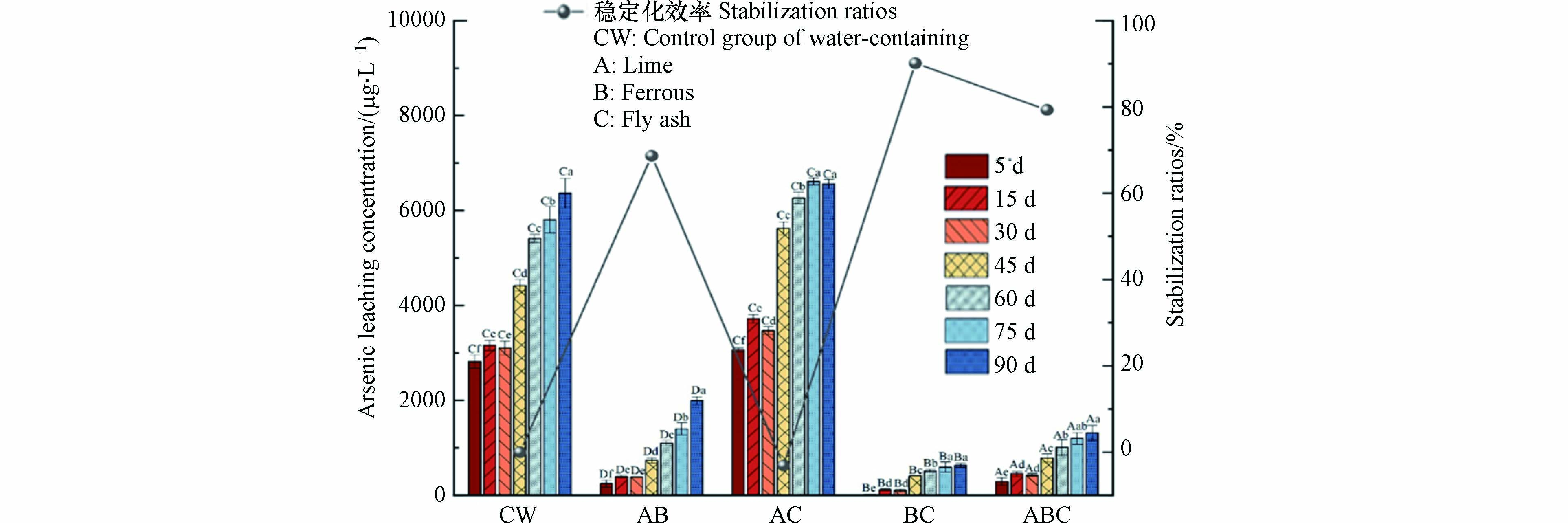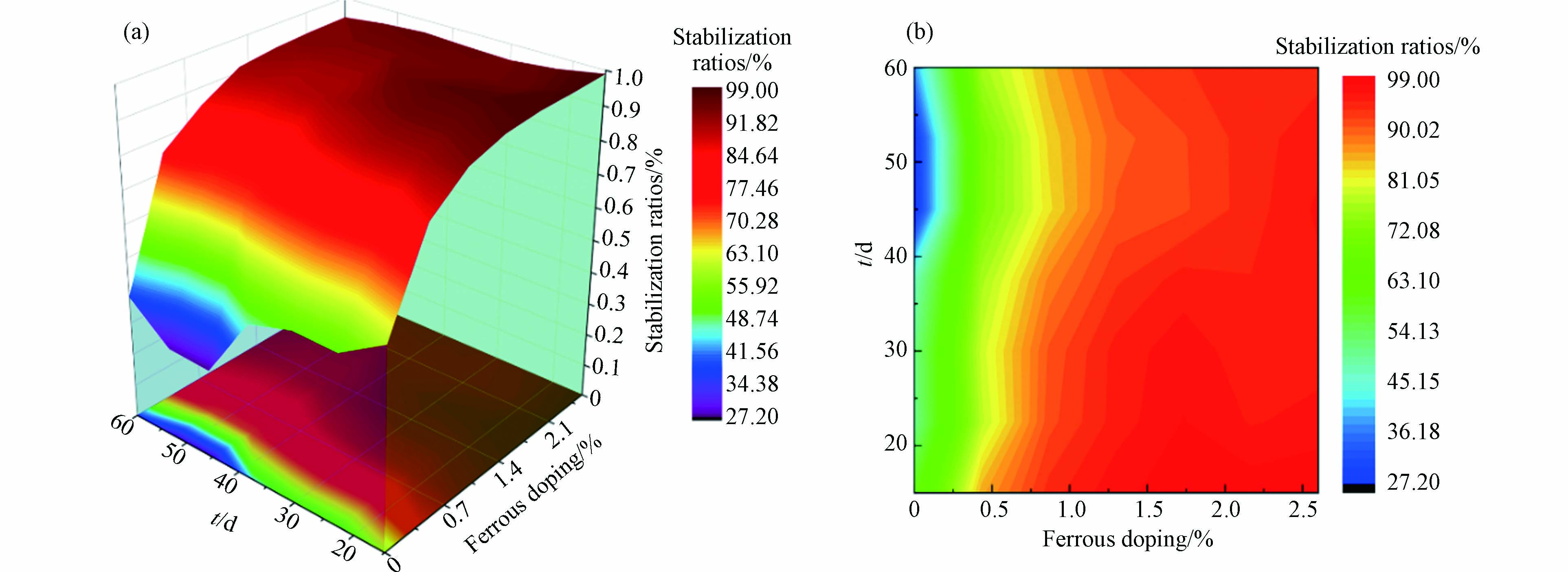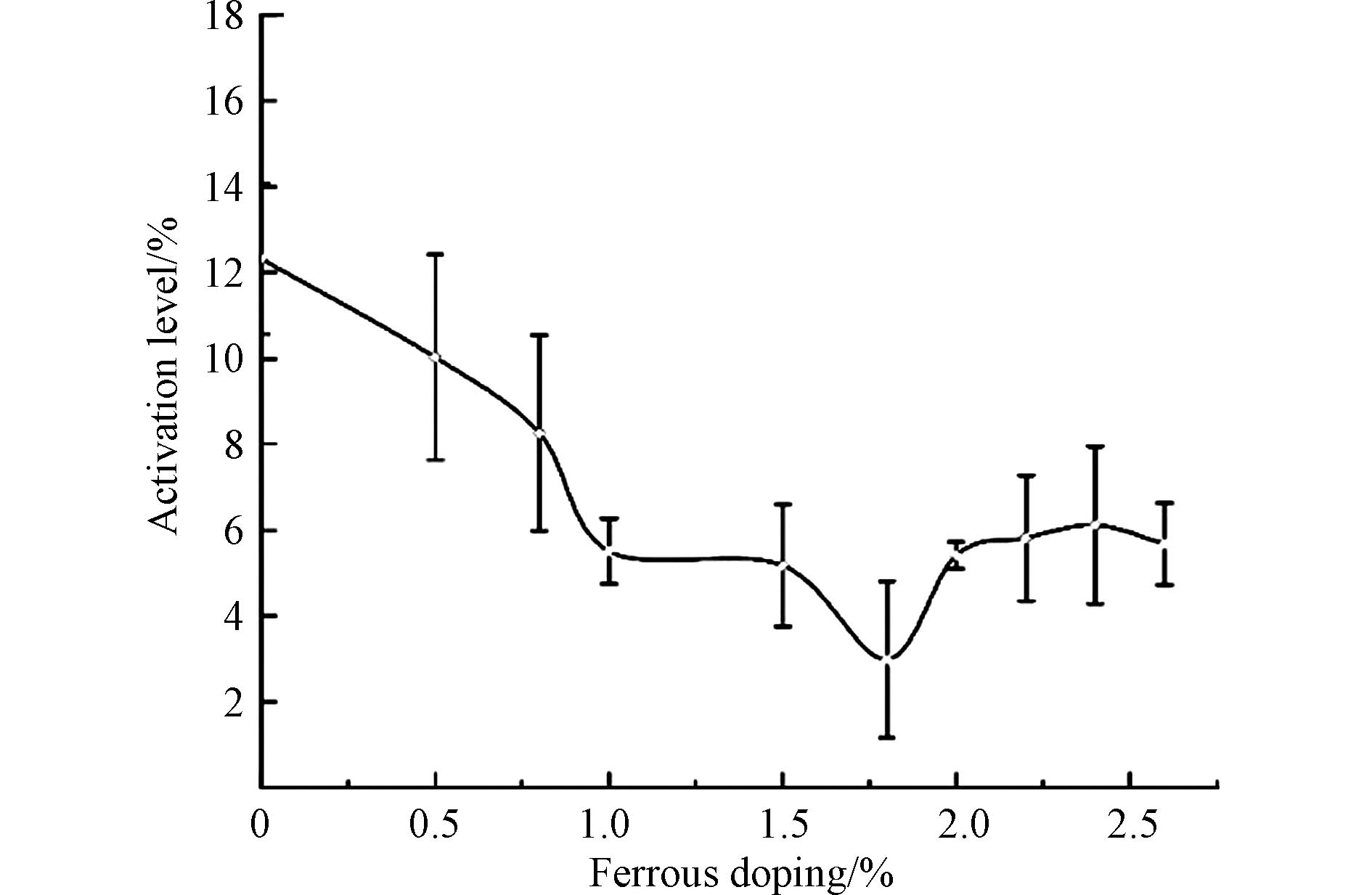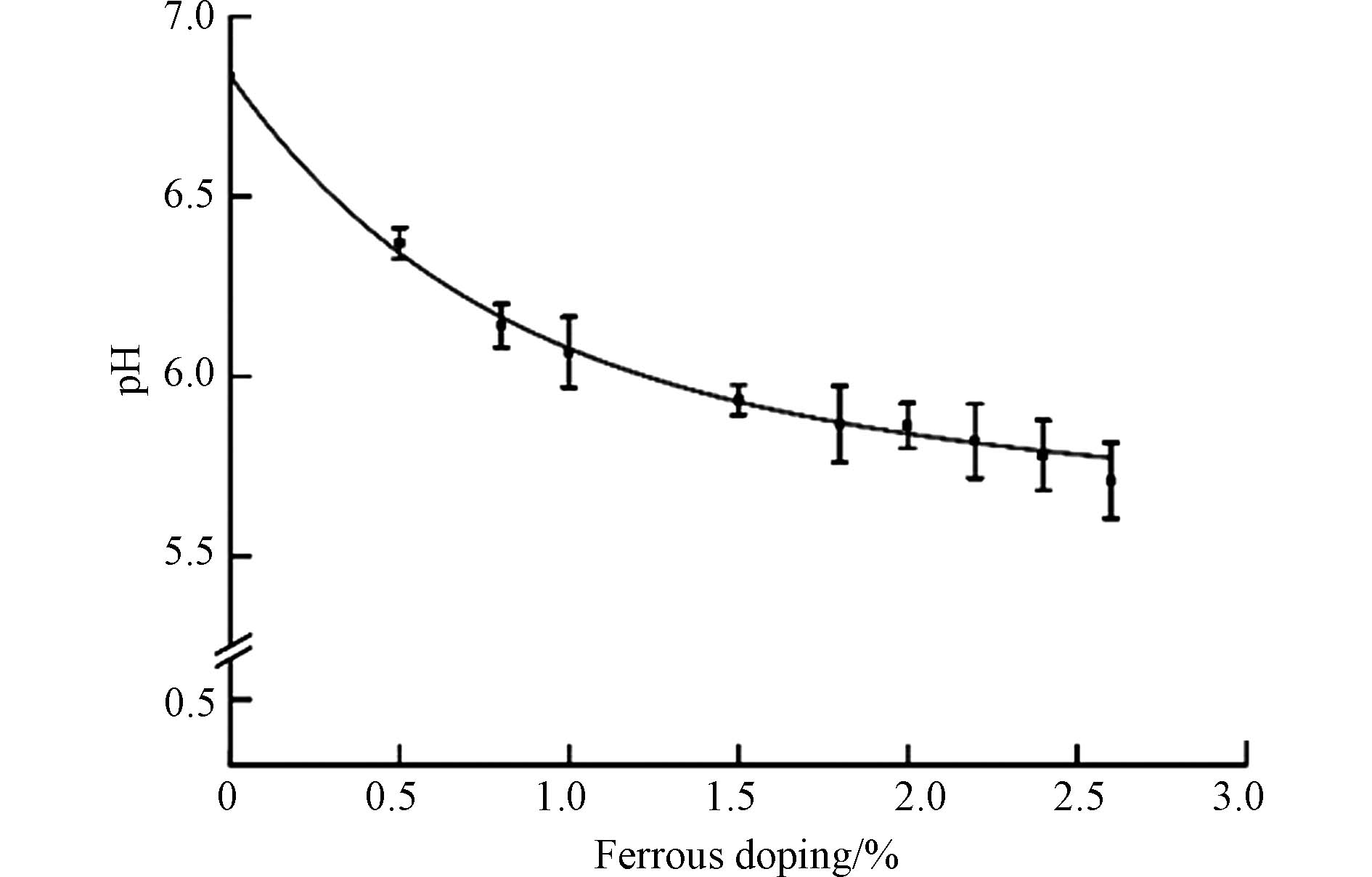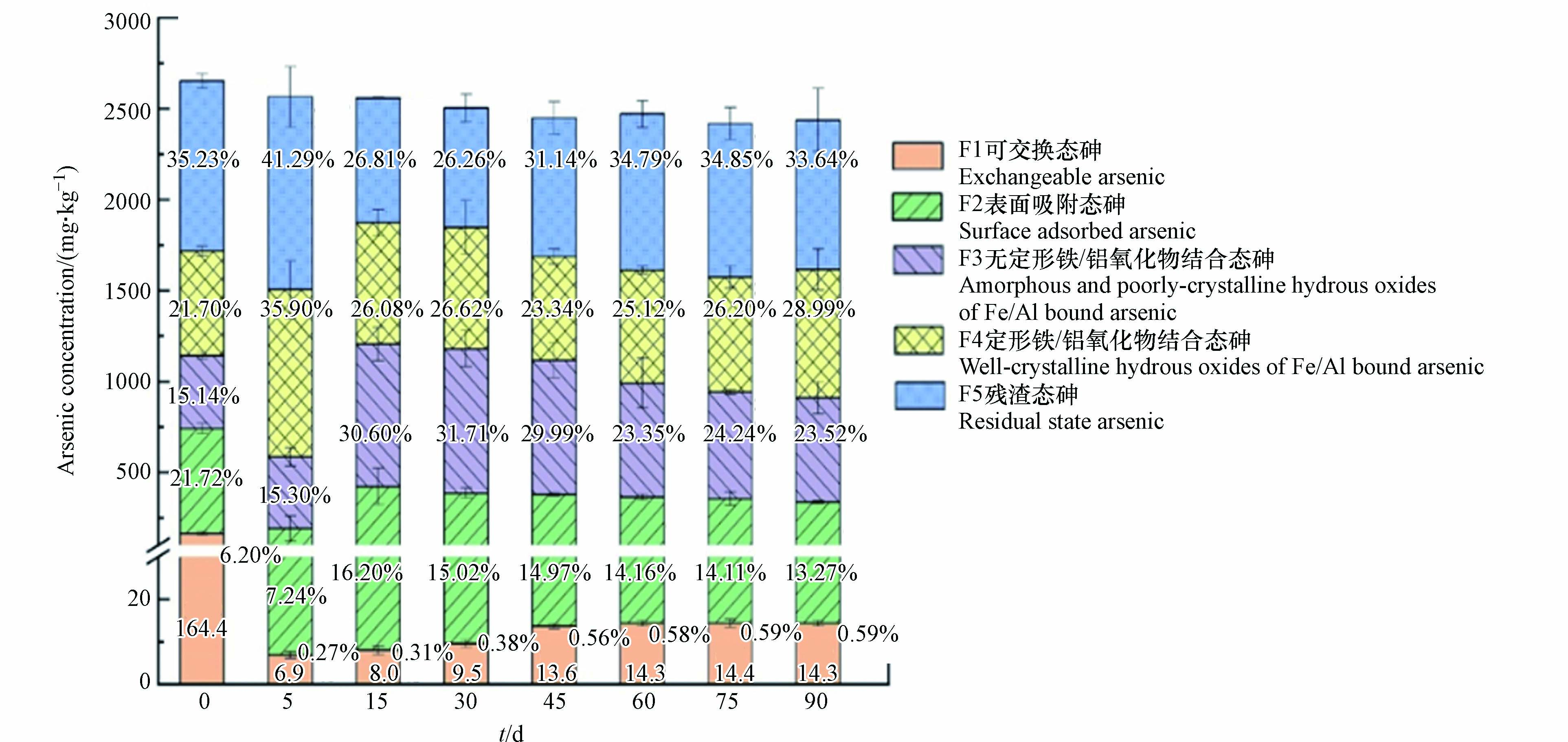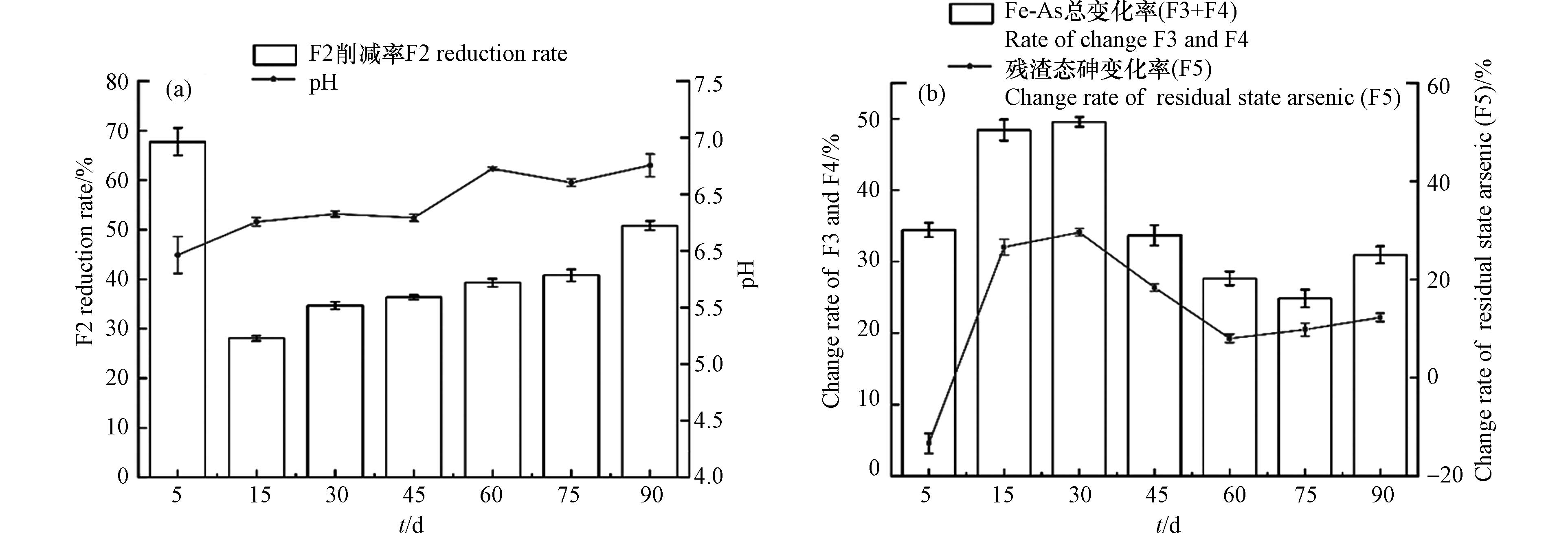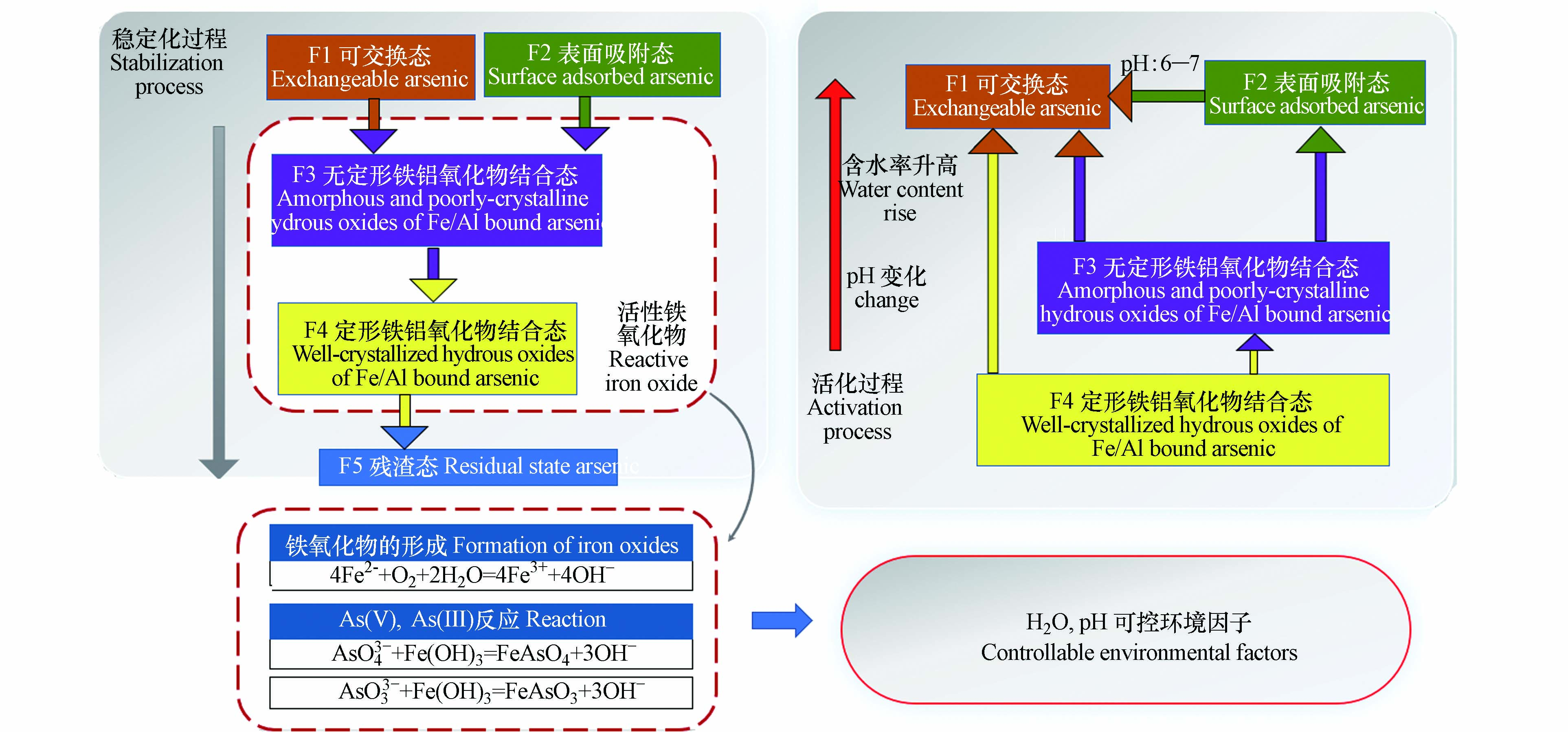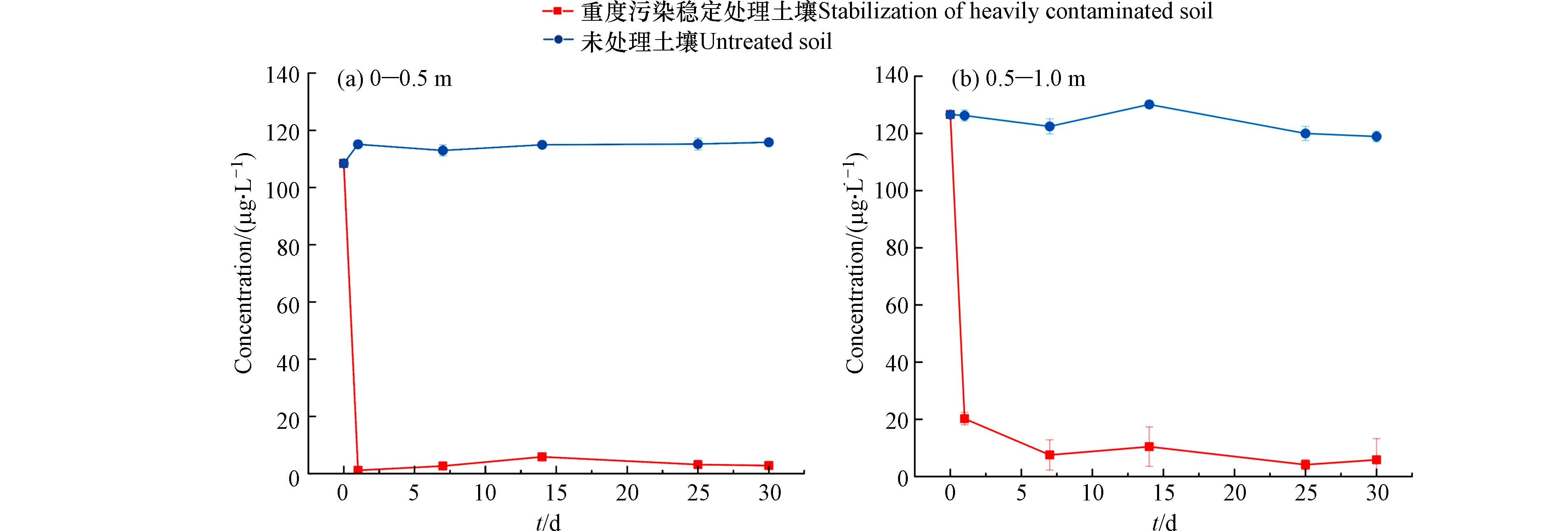-
我国城市化加速和产业结构升级推动传统工业企业转型的同时,城市内及周边区域腾退了大量的工业遗留污染场地. 据生态环境部不完全统计,我国面积大于1万m2的污染场地已超过了50万块[1]. 2014年《全国土壤污染状况调查公报》显示,我国工矿业废弃地土壤环境问题突出,工业废弃地超标点位占全部点位的34.9%,土壤样品中有2.7%存在砷污染[2]. 有研究显示,中国土壤地下水中砷浓度超过10 μg·L−1的区域范围已达到58万km2,在我国新疆塔里木盆地、内蒙古、甘肃黑河、河南、山东等地共2000万居民生活在土壤砷污染高风险区[3].
通过减小污染物在土壤中的含量、控制污染物的迁移和扩散、降低敏感受体环境暴露风险均可以实现土壤污染风险管控的目的. 土壤污染稳定化技术具有二次污染小、经济实用、实施周期较短、修复效果稳定等优势,在土壤修复领域得到广泛关注与应用,2018年的工程应用热点技术中,稳定化、固化技术的应用比例为48.5%[4 − 7]. 已有研究表明,活性炭、赤泥、铁、铝、锰等成分对土壤重金属固定效果显著[8 − 10]. 粉煤灰是来源于电厂燃煤等产生的一种固体废物,煤炭中Al、Si等组分在高温煅烧成熔融状态下,与磁性铁矿物性结合成粒度均匀、孔隙率大、比表面积高的玻璃相磁珠结构,经无害化处理后资源化利用前景良好[8 − 10]. 同时,粉煤灰中的二氧化硅、氧化铝等硅酸盐组分的活性可在机械研磨,碱激发(如石灰)、酸激发、盐激发等外界手段刺激后遇水发生水化反应,生成水化硅酸钙或水化铝酸钙等不同晶质产物[11]. 以粉煤灰为基底,通过激发增强其表面反应活性,能够将特定的重金属离子固定形成新的晶体结构,使其不易向环境中再次迁移[12 − 15],显著提升了重金属的稳定化能力. 前人研究中,稳定化技术主要用于工业场地的土壤重金属污染管控效果,较少关注土壤稳定后重金属赋存形态的变化,对稳定后重金属各形态的浸出能力缺乏评价. 不同重金属形态含量变化是导致重金属稳定后再活化的直接原因,明确重金属稳定与活化的环境过程,探讨土壤中各形态砷的浸出变化过程成为土壤污染修复长效稳定的关键,是土壤风险管控研究重点和趋势[4,12,16 − 18].
本研究在粉煤灰机械研磨改性的基础上,添加石灰、硫酸亚铁等进行联合激发改性,构建了球磨下“亚铁+粉煤灰”的联合改性处理体系. 通过土壤培养研究其稳定化效果,确定改性组合并展开粉煤灰激发因子优化实验. 跟踪监测了土壤稳定与振荡浸出过程中砷化学形态分布含量变化,探讨砷稳定、活化过程与各形态浸出能力. 从粉煤灰结构特点与成分表征结果,验证其作绿色修复剂的可行性,并将修复体系应用于实际砷污染场地,为土壤砷污染修复长效稳定性研究提供经验和技术支持.
-
采集湖北省某医药化工腾退地块土壤,分别采集期前期调查[19]中Muller 指数[20]分级下的重度污染鲜土30 kg,深度为0—20 cm,存放在尼龙袋中. 土壤自然风干后,使用鄂式破碎机粉碎,过100目筛,经行星混合机在转速50 r·min−1混合15 min后,制成均质污染土壤备用待测,其基本理化性质及砷含量见表1.
石灰(CaCO3)、七水合硫酸亚铁(FeSO4·7H2O)均为市售分析纯;粉煤灰呈弱磁性粉末状,pH为10.19,品质达到《用于水泥和混泥土中的粉煤灰》(GB/T 664—2011)相关要求[21].
-
采用SU—
8010 型场发射扫描电子显微镜(SEM, 日本日立公司)扫描物质表面结构;使用SEM配置的X射线能量色散谱(EDS)进行元素分析. 利用D8 Advance X型射线衍射仪(XRD,德国BRUKER AXS公司)观测物相和结晶度,具体条件为CuKa辐射,测试电压40 kV,电流40 mA,扫描角度范围5°—85°,波长0.02°,速度为1(°)·min−1. -
基于球磨机械与不同化学刺激联合改性的方式对粉煤灰基材料进行激发,包括碱激发(石灰),盐激发(硫酸亚铁),联合激发等. 不含粉煤灰的组分做相同处理对照,共设置5组实验. ①不作处理的干样对照(CK)与只做含水率处理的对照组(CW);②石灰与硫酸亚铁(AB);③硫酸亚铁与粉煤灰(BC);④石灰与粉煤灰(AC);⑤石灰、硫酸亚铁、粉煤灰(ABC);每个实验组重复3次. 根据前期实验成果以及前人研究[22 − 27],设计实验组中各成分的添加量为土壤质量的2%(W/W).
具体实验步骤:采用微型行星式球磨仪(F—P400E)对各实验组进行球磨机械混合. 研磨球料比为 10:1、公转转速为 120 r·min−1、时间为15 min. 将600 g处理后的均质土壤置于1L烧杯中,按设计添加药剂后用HDPE膜密封烧杯,置于磁力搅拌装置上缓慢搅拌,使土壤与药剂混合均匀. 在封口膜上均匀开孔以便于定期淋溶无菌水,保持稳定含水率.
-
使用不同浓度硫酸亚铁对粉煤灰进行激发强化,保持粉煤灰添加量2%(W/W)不变,设置硫酸亚铁浓度梯度为0、0.5%、0.8%、1.0%、1.5%、1.8%、2.0%、2.2%、2.4%、2.6%(W/W)共10组实验. 具体实验操作与1.3节相同,稳定化周期共60 d.
-
土壤砷浸出浓度依据《固体废物浸出毒性浸出方法硫酸硝酸法》(HJ/T299—2007)[28]测定, 将质量比为2:1的浓硫酸和浓硝酸混合滴加到超纯水中(1 L水约2滴混合液),使pH为3.20±0.05,备用. 称取20 g供试污染土壤置于提取瓶,按液固比为10:1 (V/W)加入200 mL浸提液,盖紧瓶盖后放于翻转振荡箱内,转速30 r·min−1,22℃下振荡18 h. 取出样品静置分层后,使用直径为0.45 μm孔径过滤器过滤上清液至10 mL离心管中,4 ℃下保存待测. 土壤砷形态分级测定参照Wenzel等提出的连续提取法[29],用0.05 mol·L−1 的(NH4)2SO4、NH4H2PO4、草酸铵、抗坏血酸等分别提取可交换态砷(F1)、表面吸附态砷(F2)、无定型铁铝氧化物结合态砷(F3)、定型铁铝氧化物结合态砷(F4)、残渣态砷(F5),提取液于4 ℃下保存待测. 土壤pH值的测定参照《土壤pH值的测定电位法》(HJ 962—2018)[30],总砷测定采用《土壤和沉积物12种金属元素的测定 王水提取—电感耦合等离子体质谱法》(HJ803—2016)[31].
-
所有样品放置于装有蓝冰的低温保温箱中送回实验室分析,采取运输空白、全程空白、实验室空白等质量控制措施;每批样品前处理时制作批次总数10% 的平行样品;分析时采取校准曲线和标准物质(GBW07930、GBW07938)检查仪器稳定性.
-
为便于对比不同激发组合下粉煤灰对重金属砷的稳定化能力,定义修复药剂对土壤砷的稳定化效率(%)与活化程度(%):
式中,C0 为同期含水对照土壤中砷浸出浓度,mg·L−1; Ce为修复结束最终砷浸出浓度,mg·L−1; Ca为加入修复药剂后第a天土壤中砷浸出浓度,mg·L−1; Cb为加入修复药剂后第b天土壤中砷浸出浓度,mg·kg−1;0<a<b.
-
综合实验结果与场地实际,选取场地中重度污染区域土壤进行稳定化修复. 清挖污染实验区域共200 m2,深度为2 m,处理污染土方量约为400 m3,土壤重金属砷平均浓度为
1205.88 mg·kg−1,稳定化处理30 d内土壤pH总体维持在6.5—6.8,有机质平均含量为16.3 mg·kg−1,含水率整体处于25%—31%,垂直平均渗透系数Kv(10−7 cm·s−1)为1.64,水平平均渗透系数Kh(10−7 cm·s−1)为2.69.具体步骤为:(1)对修复范围内污染土壤进行清挖,混合后堆存在预处理区域,一组作为中试修复实验组;另一组为对照. 采用Allu 筛分破碎铲斗对污染土壤进行初筛,除去大型石块与垃圾. (2)添加粉煤灰基稳定剂. 先用挖机将污染土壤平整堆放,然后在其表面均匀铺撒药剂,随后使用Allu筛设备进行药剂与土壤的精细筛分与混合,最后原位回填至修复区域. (3)土壤洒水养护与定期检测. 将土壤进行分层开展修复效果评估,深度为0—0.5 m、0.5—1.0 m两个梯度,采集砷稳定化处理0、1、7、14、25、30 d时土壤,同步采集对照土壤,监测修复区域土壤砷浸出浓度含量变化.
-
粉煤灰呈较规则的球形颗粒(图1a),表面存在不规则隆起结构,有密集细纹分布(图1b);球体大小不一(图1c),存在聚集而成表面附着晶体的絮状物质图(图1d),Geldart在粉体颗粒的结构研究中表明,颗粒粒径小于20 μm时,由于颗粒间的作用力远大于其重力作用,表现出一定的团聚性及黏附特性[32];Davidovits在地质聚合物的相关研究中发现,粉煤灰在空气湿度较大时发生部分溶解-聚合反应,化学上称为水化反应,生成的硅氧四面体、铝氧四面体组成三维网状结构的无机硅铝质聚合凝胶材料,描述均与SEM结果一致(图1d)[33 − 34]. XRD结果表明(图1e),粉煤灰中晶相组分主要是莫来石(Al6Si20O13)和石英(SiO2). 为20°—35°区域出现隆起峰, 同时衍射图的背底较高,表明粉煤灰中均存在着玻璃体、未燃尽的碳粒及未结晶的其它氧化物[35]. EDS结果表明(图1f),粉煤灰主要元素为Al、Si、K、Ca、Na等,主要以氧化物形式存在,未见毒害性元素.
-
图2是不同激发因子稳定土壤砷实验结果,亚铁盐激发处理粉煤灰(BC)具有显著稳定化效果,亚铁盐为最佳激发因子. 国内外研究中常有铁系物质作改性剂处理粉煤灰、活性炭等比表面积高、孔隙率大的基底物质,提高其对As的固持能力[36]. 亚铁盐(B)是常用于处理重金属的化学稳定剂,稳定过程中易被氧化成铁及其氧化物,具有表面电荷高,吸附能力强和离子交换能力好等优点[4,26 − 27]. Kim等[37]和Seidel等[38]在研究Au/Ag/Pb/Zn/Sn/W尾矿区域的As稳定化处理时,也发现硫酸亚铁对砷稳定化效果起促进作用,稳定过程中粉煤灰基底表面生成铁氧化物,提升了颗粒表面磁性,能有效提高颗粒分散性,增强其吸附效率. 污染物吸附稳定过程中,会伴随土壤理化性质发生改变,pH的变化是表明土壤中溶解—沉淀等化学反应行为趋势的重要指标之一. 在稳定药剂的施用中含有硫酸亚铁(B)成分时,会显著降低土壤中pH,现行工程技术通常添加石灰(A)对土壤pH进行缓冲[37 − 38],而本实验中各组土壤稳定后pH分别为CK(6.78)、CW(6.97)、AB(7.15)、AC(7.80)、BC(6.06)、ABC(7.10),石灰-硫酸亚铁(AB)的施用会导致pH过高,使得土壤呈碱性,环境中存在的OH-离子含量越高,阴离子吸附竞争现象越显著,造成砷酸根亚、砷酸根等有效态砷的固定效果减弱[36 − 38],进而影响土壤砷的稳定. 而硫酸亚铁-粉煤灰(BC)处理组土壤pH得到了良好缓冲,因此在最佳处理组(BC)激发因子优化中,需进一步评价稳定化过程中不同掺量与各时期pH、含水率、砷形态等因素变化,探究土壤砷稳定影响因素.
-
图3为最佳激发因子掺量对土壤砷稳定化影响. 结果表明,2%(W/W)为最佳掺量,Fe2+成分为0.4%(W/W),稳定化效率最好. 图3a是3D映射曲面图,在总砷浓度为
2884.47 mg·kg−1的亚铁-粉煤灰处理组中,随着亚铁盐掺量的提升,稳定化效率逐渐升高并逐渐收敛,2%(W/W)掺量点位处趋势接近饱和,稳定化效率达到最高,为90.43%,并在养护时间内维持90%以上,表明掺量此时已满足土壤中重金属砷稳定化需求. 图3b为等高线图,X轴向右推进时,在控制粉煤灰基质数量下,激发因子掺量逐渐升高,稳定化效率随之提升. 0.5%(W/W)掺量激发因子时,稳定效率的上升速度最大,粉煤灰稳定砷的效率提升201.93%,此时Fe/As成分比为5:2,与Moore研究结果相符[39],养护时间内稳定化效率持续稳定在75%以上. Y轴向上推进时,稳定周期逐渐后移,稳定化效率均出现小幅降低,第45天时浮动最显著. -
亚铁掺量在2.0%—2.6%(W/W)下重金属砷活化程度较低. 依据第45天和第15天实验结果(a=15,b=45),采用活化程度公式对稳定化效率浮动进行评价,结果如图4所示. 随着亚铁盐掺量的增加,在0—1.8%(W/W)内总体呈下降趋势,1.8%(W/W)后缓慢回升,说明活化程度受掺量的影响主要集中在0—1.8%(W/W),此间掺量越高,活化程度越大.
-
土壤pH是影响重金属活化的重要环境因素,亚铁盐成分的会降低土壤pH,2.0%(W/W)掺量对pH变化影响较小,对稳定化效果与活化程度影响最低. 依据实验结果,采用SPSS 26与Origin 2021对亚铁盐掺量与土壤环境pH变化进行回归分析,结果符合ExpDec1模型,如表2所示. 模型P值<0.05,表明回归模型显著. 根据模型方差结果可知R2=
0.9931 ,表明99.31%亚铁盐因子数据的变异性可以用该模型解释,可信度较高. 曲线拟合见图5,亚铁盐浓度和pH呈现较好的线性相关,随着亚铁盐浓度的升高,pH趋势逐渐收敛. 掺量提升至1.8%(W/W)后,pH变化率持续<4.18%, 表明掺量在1.8%—2.6%(W/W)时,亚铁盐浓度变化对pH的影响较低,从而对稳定化效率影响较小,与活化程度评价结果一致. -
含水率变化越低越有利于维持土壤砷稳定. 干样对照组(CK)砷浸出浓度在稳定化周期内无明显变化,土壤干燥状态下污染物较稳定,不易发生污染物迁移扩散浸出. 最佳处理体系含水率变化见图6,在第45天人为提升体系含水率10%—12%,模拟土壤受水环境胁迫情况. 45 天前后含水率变化对比,0—45 d<4%,60—90 d<2%. 结果表明,含水对照组(CW)与最佳处理组的pH在45 天后小幅上升,随后减缓,逐渐趋于中性稳定,含水率增加会加速土壤中H+的反应及离子交换作用,对pH的稳定影响较小,含水率的变化影响土壤砷形态赋存环境,加快稳定/活化过程中的化学反应可浸出形态砷增加.
-
稳定后砷为铁氧化物结合态(F3+F4)和残渣态(F5), 形态含量及分布变化见图7.
稳定过程中土壤砷总量略微降低,稳定前45天各形态含量变化幅度较大,并在60 d后形态分布逐渐趋于稳定,说明稳定化过程主要在前45天发生化学反应,各形态发生明显转化,60 d后应达到平衡,土壤趋于稳定. 稳定后,F1、F2含量均减少,F1含量削减率为91.3%,F2含量削减率为50.84%,F3、F4、F5均含量增加,F3+F4砷形态分布在0—30d稳定初期显著增加,45—60d时出现略微降低,随后保持增长,最终稳定时增加了15.65%. 在稳定0—30d内,F3形态砷分布比例随稳定周期推移显著上升,增长率为102.11%,F4形态砷分布比例在0—5d时显著增长,增长率为65.44%;45d时,F3、F4的形态分布由于含水率增加了8%而分别降低,稳定周期为45—90 d阶段时,随时间推移,F2、F3分布比例略微下降,而F1、F4分布比例逐渐上升,Fe—As结合态的F3+F4总量分布增加15.65%,逐步趋于稳定. 说明最佳体系稳定过程主要将土壤F1、F2形态砷逐步固定在F3、F4中,活化浸出主要发生在F2、F3的释放,并发生了向F1的转化,表明该体系主要将各形态砷通过铁氧化物吸附结合的形式实现砷污染稳定化,结果与以往研究相同,Fe—As结合态是化学处理砷污染物后的主要形态[14,15]. 稳定周期内,可交换态(F1)和表面吸附态(F2)含量显著降低后缓慢回升并趋于稳定,推测F1、F2是最佳体系处理下土壤活化后影响砷浸出浓度的主要形态.
可交换态(F1)砷浓度是影响土壤砷浸出的主要因素,与浸出液砷浓度呈正相关. 依据实验结果,采用SPSS 26 与Origin 2021 对不同稳定时间下,F1形态削减变化率、稳定化效率分别进行回归分析,结果均符合Asymptotic1模型,见表3. 模型P值均<0.05,拟合效果显著. 根据模型方差结果,F1削减率R2=
0.93293 、稳定化效率R2=0.93218 ,表明二者93%以上的数据存在同一模型,且相关性好,可信度较高. 曲线拟合结果见图8,随稳定时间($ x $ )的推移,稳定化效率和F1削减率变化趋势基本一致,说明可交换态(F1)是土壤砷浸出的主要形态,显著影响砷的浸出,F1分布数量越多,砷浸出浓度越大.表面吸附态(F2)砷在土壤pH为6—7时最易解吸,pH是其活化的主要因素. F2削减率变化见图9a,稳定前5天内,由于加药稳定,F2显著降低. 稳定第15天,土壤pH水平达到6—7,F2削减率显著降低,随着稳定周期推移,F2削减率与土壤pH均稳步回升,说明F2在pH为6附近发生大量解吸,并且随pH回升解吸能力逐步减弱,结果与Goh等[40]与陈静等[41]研究一致. pH在6—7时,表面吸附态砷(F2)最易发生解吸;pH>7时,砷的解吸量随pH的变化并不明显,修复效果趋于稳定[40 − 41].
铁氧化物(F3+F4)、残渣态(F5)容易受水环境胁迫影响发生解吸,含水率升高是其活化的因素. F3+F4、F5削减率变化见图9b,F3+F4、F5变化总体呈增加,变化趋势保持一致,这也说明F3、F4、F5是土壤砷被稳定处理后转化的主要形态. 稳定前45 d,F3+F4、F5显著增加并趋于稳定,45 d后变化率先降低后回升,说明含水率的扰动造成土壤中铁氧化物形态砷与部分残渣态砷发生解吸,造成F3、F4形态与部分F5活化. 结果与已有研究相同,卢聪等[42]在用 FeSO4和生石灰对土壤中的砷进行稳定化时,发现砷的结合形态也主要向F3转变,比例由22.3%升高到57.1%. 研究表明[43 − 45],Fe2+系稳定剂在酸性或中性的含水条件下易被氧化生成Fe3+, Fe3+不仅将环境中As3+氧化成As5+,而且会与环境中可溶性As
$ {\mathrm{O}}_{4}^{3-} $ 、As$ {\mathrm{O}}_{3}^{3-} $ 和As$ {\mathrm{O}}_{2}^{-} $ 反应生成砷酸铁、五水合亚砷酸铁沉淀,使可交换态(F1)和表面吸附态(F2)砷减少,铁氧化物结合态(F3、F4)和残渣态(F5)砷增加. -
含水率和pH的稳定控制是砷稳定化的关键因素. 以稳定后的各组土壤为对象,将其置于酸性的淹水环境下进行浸出模拟,对浸出后的土壤滤渣进行砷形态分级结果如图10所示,各组土壤中F1、F2含量升高,F3、F4含量降低,说明含水率和pH的扰动主要造成铁氧化物发生活化,造成其固定的砷(F3、F4)发生解吸,导致土壤中易发生离子交换的游离形态铁和砷(F1、F2)数量增加,使其从土壤向溶液界面扩散能力增强,造成砷浸出浓度回升. 并且迁移扩散能力F1>F2,这也说明F1为主要浸出形态.
土壤稳定/活化过程如图11所示,稳定/活化过程中主要发生铁氧化物形态的转化,pH和含水率是影响该过程的主要因素. 根据以往研究,土壤理化性质、成土母质、土地利用情况均能影响土壤重金属的有效性及风险. 其中pH(酸碱度)是决定重金属在土壤中生物有效性和迁移性的主要因素之一,亚铁盐在发挥化学稳定作用时,存在土壤酸化风险,现有研究往往采用石灰进行调控pH,造成土壤盐碱性增强,容易出现新的环境问题[44 − 47].
综上,黏性土壤含水率一般在30%时为潮湿状态,在50%时持水达到饱和,水分继续增加会呈现淹水现象. 淹水现象通常发生在水稻种植过程中,灌溉时土壤淹水利于铁氧化物的活化,即从晶质铁向无定形铁和离子态铁的转化;而在排水或者干旱时,土壤铁氧化物由离子态铁和无定形铁向晶质铁转化[48 − 50],过高的含水率或土壤淹水均会导致铁氧化物分解,继而造成土壤Fe-As结合态含量减少(F3、F4),土壤可交换态砷(F1)与表面吸附态砷(F2)增加. 因此,将亚铁盐通过粉煤灰激发的形式施用于土壤,稳定化效率首先得到增强,并且粉煤灰成分不仅能够调控土壤pH,还能改善了土壤的持水性,减缓土壤水分向下迁移扩散的能力,将水分有效贮存在粉煤灰施用部分,维持对应深度土壤的吸水需求[46 −47],有利于土壤水分的稳定分布,减缓土壤重金属的活化.
-
稳定化中试修复30 d时,表层土壤(0—0.5 m)砷稳定化效率为97.41%,砷浸出浓度稳定为2.8 μg·L−1;深层土壤(0.5—1.0 m)砷稳定化效率为95.37%,砷浸出浓度稳定为5.8 μg·L−1,具体结果见图12. 实际场地修复30 d内不同深度土壤砷稳定化效率持续在95%以上,各深度土壤浸出液砷浓度均满足地表水环境质量(GB
3838 —2002)[51]中规定的砷Ⅲ类标准(0.05 mg·L−1),达到了地下水环境质量(GB/T14848 —2017)[52]中规定的砷Ⅲ类标准(0.01 mg·L−1),修复效果显著. -
粉煤灰经过铁盐(硫酸亚铁)激发改性后可作稳定剂应用于土壤修复中,能够有效减缓土壤重金属的活化. 最佳处理为2%(W/W)硫酸亚铁+2%(W/W)粉煤灰,对土壤砷污染稳定化作用效果最显著. 土壤培养实验中亚铁-粉煤灰体系(BC)处理组总砷浓度为
2884.47 mg·kg−1,稳定90 d周期内对砷的稳定化效率为90.43%.稳定化过程主要将土壤中可交换态砷(F1)与表面吸附态砷(F2)固定在铁氧化物结合态砷(F3+F4)及残渣态砷(F5)中,且稳定性F5>F4>F3. 稳定后F2含量削减率为50.84%,F1含量削减率为91.3%;土壤中F1含量变化与浸出液砷浓度呈正相关.
F1是影响土壤砷浸出液浓度的主要形态,含水率和pH是影响稳定/活化的重要因素. 水分升高造成铁氧化物结合态砷(F3+F4)发生解吸而活化,pH为6—7时造成表面吸附态砷(F2)吸而活化,最佳处理会使土壤pH降低12%,稳定后逐步回升趋于中性. 土壤砷活化过程主要由F3、F4转化为F1、F2.
实际场地中试修复效果显著,采用总砷为
1205.88 mg·kg−1的重度污染土壤,表层土壤(0—0.5 m)砷稳定化效率为97.41%;深层土壤(0.5—1.0 m)砷稳定化效率为95.37%,土壤浸出液砷含量满足修复要求,具有良好的应用潜力.
亚铁激发下粉煤灰基土壤砷污染稳定化技术
Research on soil of arsenic pollution stabilization technology based on fly ash modify stimulated by Ferrous
-
摘要: 以湖北省某典型医药化工腾退场地土壤为对象,采用“机械+化学”手段对粉煤灰进行激发改性,通过不同配比石灰、硫酸亚铁与粉煤灰进行机械球磨混合后实施土壤培养实验与场地修复. 研究结果表明,土壤培养实验90 d内亚铁盐改性粉煤灰组合下土壤砷稳定化效率为90.43%,实际场地修复30 d内不同深度土壤砷稳定化效率持续在95%以上,稳定化效果显著;最佳改性药量为2%硫酸亚铁+2%粉煤灰,此体系稳定化后土壤砷主要形态为无定型与定型铁氧化物结合态(F3+F4)、残渣态(F5). 含水率和pH的波动主要造成F3、F4活化,活化后为可交换态(F1)、表面吸附态(F2),F1是砷浸出主要形态. 本研究研发的粉煤灰基土壤砷污染稳定化材料可“以废治污”,应用潜力巨大.Abstract: Taking the soil of a typical pharmaceutical and chemical industry relocation site in Hubei Province as the object, the fly ash was modified by “mechanical + chemical” means. After mechanical ball milling with different proportions of lime, ferrous sulfate and fly ash, soil culture experiments and site restoration were carried out. The results showed that: 1. The arsenic stabilization efficiency of the soil in the ferrous salt modified fly ash combination in the soil culture experiment was 90.43% within 90 days, and the arsenic stabilization efficiency of different depths of soil in the actual site restoration was above 95% within 30 days, and the stabilization effect was significant; 2. The optimal modified dosage was 2% ferrous sulfate + 2% fly ash. After stabilization, the main forms of arsenic in the soil were non-formalized and formalized iron oxide complexes (F3 + F4), and residual state (F5). 3. The fluctuation of water content and pH mainly caused F3 and F4 to be activated, and after activation, they were exchangeable (F1) and surface adsorbed (F2). F1 was the main form of arsenic leaching. Fly ash based restoration technology can “treat waste and control pollution”, and has great application potential.
-
Key words:
- fly ash /
- modify stimulate /
- stabilization /
- soil arsenic morphology /
- site remediation.
-

-
表 1 供试土壤基本理化性质
Table 1. Physical and chemical properties of the tested soil
土壤类型
Soil type天然含水率/%
Natural water content土壤有机质/(g·kg−1)
Soil organic matterpH 总砷/(mg·kg−1)
Total arsenic六六六/(mg·kg−1)
Hexachlorocyclohexane滴滴涕/(mg·kg−1)
Dichloro-Diphenyl-Trichloroethane黏土 31.4 15.6 6.16 2749 0.002 0.014 表 2 因子掺量—pH模型拟合结果
Table 2. Physical and chemical properties of the tested soil
模型: ExpDec1
Model: ExpDec1$ y={A}_{1}\times \exp\left(-\dfrac{x}{{t}_{1}}\right)+{y}_{0} $ y0 5.7115 ±0.0340 A1 1.1228 ±0.0356 t1 0.9062 ±0.0835 P值 <0.05 R2 0.9931 Radj2 0.9912 表 3 稳定期间可交换形态(F1)削减率、稳定化效率模型拟合结果
Table 3. Exchangeable form (F1) reduction rate during stabilization, stabilization efficiency model fitting results
模型: Asymptotic1
Model: Asymptotic1$ y=a-b\times {c}^{x} $ 最佳处理F1削减率
Optimal treatment of F1 reduction rate最佳处理稳定化效率
Optimal treatment stabilization efficiencya 90.10548 ±1.44295 89.0191 ±1.73706 b − 6.80932 ±1.17875 − 12.58449 ±1.71389 c 0.97636 ±0.01293 0.96845 ±0.01427 P值 <0.05 <0.05 R2 0.93293 0.93218 Radj2 0.90861 0.90786 -
[1] 金远亮, 侯德义, 田莉, 等. 基于用地规划的污染地块修复多目标优化研究[J]. 中国环境科学, 2021, 41(2): 787-800. doi: 10.3969/j.issn.1000-6923.2021.02.034 JIN Y L, HOU D Y, TIAN L, et al. Multi-objective optimization for brownfield remediation on the basis of land use planning[J]. China Environmental Science, 2021, 41(2): 787-800 (in Chinese). doi: 10.3969/j.issn.1000-6923.2021.02.034
[2] 中华人民共和国生态环境部, 国土资源部. 全国土壤污染状况调查公报[R/OL] 2014-04-17
[3] BERG M, TRAN H C, NGUYEN T C, et al. Arsenic contamination of groundwater and drinking water in Vietnam: A human health threat[J]. Environmental Science & Technology, 2001, 35(13): 2621-2626. [4] 侯德义, 张凯凯, 王刘炜, 等. 工业场地重金属污染土壤治理现状与展望[J]. 环境保护, 2021, 49(20): 9-15. doi: 10.14026/j.cnki.0253-9705.2021.20.002 HOU D Y, ZHANG K K, WANG L W, et al. Current status and prospect for the remediation of heavy metal contaminated industrial sites[J]. Environmental Protection, 2021, 49(20): 9-15 (in Chinese). doi: 10.14026/j.cnki.0253-9705.2021.20.002
[5] YANG B C, MA S X, CUI R J, et al. Novel low-cost simultaneous removal of NO and SO2 with ·OH from decomposition of H2O2 catalyzed by alkali-magnetic modified fly ash[J]. Industrial & Engineering Chemistry Research, 2019, 58(13): 5339-5347. [6] CHEN H X, YUAN H H, MAO L Q, et al. Stabilization/solidification of chromium-bearing electroplating sludge with alkali-activated slag binders[J]. Chemosphere, 2020, 240: 124885. doi: 10.1016/j.chemosphere.2019.124885 [7] GUERRINI I A, CROCE C G G, de CARVALHO BUENO O, et al. Composted sewage sludge and steel mill slag as potential amendments for urban soils involved in afforestation programs[J]. Urban Forestry & Urban Greening, 2017, 22: 93-104. [8] 黄丽萍, 马倩敏, 郭荣鑫, 等. 碱矿渣胶凝材料水化产物的实验研究[J]. 硅酸盐通报, 2020, 39(4): 1194-1200. HUANG L P, MA Q M, GUO R X, et al. Experimental study on hydration products of alkali-activated slag[J]. Bulletin of the Chinese Ceramic Society, 2020, 39(4): 1194-1200 (in Chinese).
[9] CHEN Z L, LU S Y, TANG M H, et al. Mechanical activation of fly ash from MSWI for utilization in cementitious materials[J]. Waste Management, 2019, 88: 182-190. doi: 10.1016/j.wasman.2019.03.045 [10] YIN B, KANG T H, KANG J T, et al. Analysis of active ion-leaching behavior and the reaction mechanism during alkali activation of low-calcium fly ash[J]. International Journal of Concrete Structures and Materials, 2018, 12(1): 1-13. doi: 10.1186/s40069-018-0237-8 [11] DING J, MA S H, SHEN S, et al. Research and industrialization progress of recovering alumina from fly ash: A concise review[J]. Waste Management, 2017, 60: 375-387. doi: 10.1016/j.wasman.2016.06.009 [12] 陈梦舫. 我国工业污染场地土壤与地下水重金属修复技术综述[J]. 中国科学院院刊, 2014, 29(3): 327-335. CHEN M F. Review on heavy metal remediation technology of soil and groundwater at industrially contaminated site in China[J]. Bulletin of Chinese Academy of Sciences, 2014, 29(3): 327-335 (in Chinese).
[13] SHEN Z T, JIN F, O'CONNOR D, et al. Solidification/stabilization for soil remediation: An old technology with new vitality[J]. Environmental Science & Technology, 2019, 53(20): 11615-11617. [14] 赵述华, 陈志良, 张太平, 等. 重金属污染土壤的固化/稳定化处理技术研究进展[J]. 土壤通报, 2013, 44(6): 1531-1536. doi: 10.19336/j.cnki.trtb.2013.06.044 ZHAO S H, CHEN Z L, ZHANG T P, et al. Advances in solidification/stabilization technology treatment of heavy metals in contaminated soils[J]. Chinese Journal of Soil Science, 2013, 44(6): 1531-1536 (in Chinese). doi: 10.19336/j.cnki.trtb.2013.06.044
[15] WEN J, YI Y J, ZENG G M. Effects of modified zeolite on the removal and stabilization of heavy metals in contaminated lake sediment using BCR sequential extraction[J]. Journal of Environmental Management, 2016, 178: 63-69. doi: 10.1016/j.jenvman.2016.04.046 [16] 吕鹏, 李莲芳, 黄晓雅. 改性生物炭修复砷镉复合污染土壤研究进展[J].环境科学, 2023, 44(7): 4077-4090. LÜ P, LI L F, HUANG X Y. Modified Biochar for Remediation of Soil Contaminated with Arsenic and Cadmium: A Review[J]. Environmental Science, 2023, 44(7): 4077-4090(in Chinese).
[17] 韦婧, 刘昳晗, 涂晨, 等. 铁修饰生物炭的制备及在砷污染土壤修复中的应用[J]. 环境科学, 2023, 44(2): 965-974. doi: 10.13227/j.hjkx.202203011 WEI J, LIU Y H, TU C, et al. Preparation of iron-modified biochar and its application in arsenic contaminated soil remediation[J]. Environmental Science, 2023, 44(2): 965-974 (in Chinese). doi: 10.13227/j.hjkx.202203011
[18] 官迪, 吴家梅, 谢运河, 等. 铁基硅盐对土壤环境镉砷赋存形态及转化影响[J]. 中国环境科学, 2022, 42(4): 1803-1811. doi: 10.3969/j.issn.1000-6923.2022.04.036 GUAN D, WU J M, XIE Y H, et al. Effects of Iron-based silicon salts on fractions and transformation of cadmium and arsenic in soil environment[J]. China Environmental Science, 2022, 42(4): 1803-1811 (in Chinese). doi: 10.3969/j.issn.1000-6923.2022.04.036
[19] 向罗京, 苏趋, 孙刚, 等. 典型医药企业聚集区土壤重金属污染特征及成因分析[J]. 环境化学, 2022, 41(6): 2022-2034. doi: 10.7524/j.issn.0254-6108.2021092402 XIANG L J, SU Q, SUN G, et al. Characteristics and causes of soil heavy metal pollution in typical pharmaceutical enterprise gathering areas[J]. Environmental Chemistry, 2022, 41(6): 2022-2034 (in Chinese). doi: 10.7524/j.issn.0254-6108.2021092402
[20] MÜLLER G. Index of geoaccumulation in sediments of the Rhine River[J]. Geology Journal, 1969, 2: 108-118. [21] 国家质量监督检验检疫总局, 国家标准化管理委员会. 中华人民共和国国家标准: 用于水泥和混泥土中的粉煤灰 GB/T 664—2011[S]. 北京: 中国标准出版社, 2018. General Administration of Quality Supervision, Inspection and Quarantine of the People’s Republic of China Standardization administration. National Standard (Mandatory) of the People’s Republic of China: Fly Ash used for cement and concrete. GB/T 664—2011[S]. Beijing: Standards Press of China, 2018 (in Chinese).
[22] XIA W Y, FENG Y S, DU Y J, et al. Solidification and stabilization of heavy metal–contaminated industrial site soil using KMP binder[J]. Journal of Materials in Civil Engineering, 2018, 30(6): 04018080. doi: 10.1061/(ASCE)MT.1943-5533.0002264 [23] 黄安林. 不同钝化材料及其复配对农田土壤中砷的钝化效果研究[D]. 海口: 海南大学, 2020. HUANG A L. Study on the passivation effect of different passivation materials and their compounds on arsenic in farmland soil[D]. Haikou: Hainan University, 2020 (in Chinese).
[24] ZHA F S, PAN D D, XU L, et al. Investigations on engineering properties of solidified/stabilized Pb-contaminated soil based on alkaline residue[J]. Advances in Civil Engineering, 2018, 2018: 1-9. [25] 焦常锋, 常会庆, 王启震, 等. 碳酸钙和壳聚糖联用对高pH值石灰性土壤砷污染的钝化[J]. 农业工程学报, 2020, 36(11): 234-240. doi: 10.11975/j.issn.1002-6819.2020.11.027 JIAO C F, CHANG H Q, WANG Q Z, et al. Passivation effects of calcium carbonate and chitosan on arsenic pollution in high pH calcareous soil[J]. Transactions of the Chinese Society of Agricultural Engineering, 2020, 36(11): 234-240 (in Chinese). doi: 10.11975/j.issn.1002-6819.2020.11.027
[26] 王鑫. 亚铁盐对固废/土壤中重金属的稳定化作用及机理研究[D]. 武汉: 华中科技大学, 2018. WANG X. Stabilization treatment of heavy metal contaminated solid wastes/soils by ferrous salt[D]. Wuhan: Huazhong University of Science and Technology, 2018 (in Chinese).
[27] 张向军. 石灰、粉煤灰处理Cd、Pb、Cr污染土壤的实验研究[D]. 重庆: 重庆大学, 2009. ZHANG X J. Experimental study on the treatment of Cd, Pb and Cr-polluted soil with lime and fly ash[D]. Chongqing: Chongqing University, 2009 (in Chinese).
[28] 生态环境部. 中华人民共和国国家标准: 固体废物浸出毒性浸出方法-硫酸硝酸法HJ/T 299-2007 [S]. 北京: 中国环境科学出版社, 2007. Ministry of Ecology and Environment of the People's Republic of China. National Standard (Mandatory) of the People's Republic of China: Solid waste-extraction procedure for leaching toxicity-sulphuric acid & nitric acid method. HJ/T 299-2007 [S]. Beijing: China Environment Science Press, 2007(in Chinese).
[29] WENZEL W W, KIRCHBAUMER N, PROHASKA T, et al. Arsenic fractionation in soils using an improved sequential extraction procedure[J]. Analytica Chimica Acta, 2001, 436(2): 309-323. doi: 10.1016/S0003-2670(01)00924-2 [30] 生态环境部. 中华人民共和国国家标准: 土壤pH值的测定 电位法. HJ 962—2018 [S]. 北京: 中国环境科学出版社, 2018. Ministry of Ecology and Environment of the People’s Republic of China. National Standard (Mandatory) of the People’s Republic of China: Soil — Determination of pH — Potentiometry. HJ 962—2018 [S]. Beijing: China Environment Science Press, 2018(in Chinese).
[31] 中华人民共和国环境保护部. 土壤和沉积物 12种金属元素的测定 王水提取-电感耦合等离子体质谱法: HJ 803—2016[S]. 北京: 中国环境科学出版社, 2016. Ministry of Environmental Protection of the People's Republic of China. Soil and sediment-Determination of aqua regia extracts of 12 metal elements-Inductively coupled plasma mass spectrometry: HJ 803—2016[S]. Beijing: China Environmental Science Press, 2016(in Chinese).
[32] GELDART D. Types of gas fluidization[J]. Powder Technology, 1973, 7(5): 285-292. doi: 10.1016/0032-5910(73)80037-3 [33] DAVIDOVITS J. Geopolymers and geopolymeric materials[J]. Journal of Thermal Analysis, 1989, 35(2): 429-441. doi: 10.1007/BF01904446 [34] DAVIDOVITS J. Geopolymers chemistry and application[M]. Saint-Quentin: National Defense Press, 2008: 41-42. [35] 陆厚根. 粉体技术导论[M]. 2版. 上海: 同济大学出版社, 1998. LU H G. Introduction to powder technology[M]. 2nd ed. Shanghai: Tongji University Press, 1998(in Chinese).
[36] 霍丽娟. 水铁矿纳米材料对土壤中砷的吸附固定及其稳定化反应机制[D]. 北京: 中国农业科学院, 2017. HUO L J. Study on the mechanisms of arsenic sorption and stabilization in soils using ferrihydrite nanoparticles[D]. Beijing: Chinese Academy of Agricultural Sciences, 2017 (in Chinese).
[37] KIM J Y, DAVIS A P, KIM K W. Stabilization of available arsenic in highly contaminated mine tailings using iron[J]. Environmental Science & Technology, 2003, 37(1): 189-195. [38] SEIDEL H, GÖRSCH K, AMSTÄTTER K, et al. Immobilization of arsenic in a tailings material by ferrous iron treatment[J]. Water Research, 2005, 39(17): 4073-4082. doi: 10.1016/j.watres.2005.08.001 [39] MOORE T J, RIGHTMIRE C M, VEMPATI R K. Ferrous iron treatment of soils contaminated with arsenic-containing wood-preserving solution[J]. Journal of Soil Contamination, 2000, 9(4): 375-405. doi: 10.1080/10588330091134310 [40] GOH K H, LIM T T. Geochemistry of inorganic arsenic and selenium in a tropical soil: Effect of reaction time, pH, and competitive anions on arsenic and selenium adsorption[J]. Chemosphere, 2004, 55(6): 849-859. doi: 10.1016/j.chemosphere.2003.11.041 [41] 陈静, 王学军, 朱立军. pH对砷在贵州红壤中的吸附的影响[J]. 土壤, 2004, 36(2): 211-214. doi: 10.3321/j.issn:0253-9829.2004.02.020 CHEN J, WANG X J, ZHU L J. Effect of ph on adsorption and transformation of arsenic in red soil in Guizhou[J]. Soils, 2004, 36(2): 211-214 (in Chinese). doi: 10.3321/j.issn:0253-9829.2004.02.020
[42] 卢聪, 李青青, 罗启仕, 等. 场地土壤中有效态砷的稳定化处理及机理研究[J]. 中国环境科学, 2013, 33(2): 298-304. doi: 10.3969/j.issn.1000-6923.2013.02.016 LU C, LI Q Q, LUO Q S, et al. Stabilization treatment of available arsenic in contaminated soils and mechanism studies[J]. China Environmental Science, 2013, 33(2): 298-304 (in Chinese). doi: 10.3969/j.issn.1000-6923.2013.02.016
[43] 宋宜, 王华伟, 吴雅静, 等. 三价铁促进生物氧化锰稳定土壤砷的效果和机制[J]. 环境科学学报, 2020, 40(4): 1460-1466. doi: 10.13671/j.hjkxxb.2019.0469 SONG Y, WANG H W, WU Y J, et al. Promoting effect and mechanism of Fe(Ⅲ) on the stabilization of arsenic by biogenic Mn oxides in contaminated soil[J]. Acta Scientiae Circumstantiae, 2020, 40(4): 1460-1466 (in Chinese). doi: 10.13671/j.hjkxxb.2019.0469
[44] 常春英, 曹浩轩, 陶亮, 等. 固化/稳定化修复后土壤重金属稳定性及再活化研究进展[J]. 土壤, 2021, 53(4): 682-691. doi: 10.13758/j.cnki.tr.2021.04.003 CHANG C Y, CAO H X, TAO L, et al. Advances on heavy metal stability and reactivation for soil after solidification/stabilization remediation[J]. Soils, 2021, 53(4): 682-691 (in Chinese). doi: 10.13758/j.cnki.tr.2021.04.003
[45] 陈子万, 许晶, 侯召雷, 等. 基于成土母质分区的土壤-作物系统重金属累积特征与健康风险评价[J]. 环境科学, 2023, 44(1): 405-414. doi: 10.13227/j.hjkx.202203205 CHEN Z W, XU J, HOU Z L, et al. Accumulation characteristics and health risk assessment of heavy metals in soil-crop system based on soil parent material zoning[J]. Environmental Science, 2023, 44(1): 405-414 (in Chinese). doi: 10.13227/j.hjkx.202203205
[46] 赵亮, 唐泽军, 刘芳. 粉煤灰改良沙质土壤水分物理性质的室内实验[J]. 环境科学学报, 2009, 29(9): 1951-1957. doi: 10.3321/j.issn:0253-2468.2009.09.024 ZHAO L, TANG Z J, LIU F. Laboratory tests of fly ash as a sandy soil amendment and its effects on soil water[J]. Acta Scientiae Circumstantiae, 2009, 29(9): 1951-1957 (in Chinese). doi: 10.3321/j.issn:0253-2468.2009.09.024
[47] KALINSKI M E, YERRA P K. Hydraulic conductivity of compacted cement-stabilized fly ash[J]. Fuel, 2006, 85(16): 2330-2336. doi: 10.1016/j.fuel.2006.04.030 [48] 杨忠兰, 曾希柏, 孙本华, 等. 铁氧化物固定土壤重金属的研究进展[J]. 土壤通报, 2021, 52(3): 728-735. doi: 10.19336/j.cnki.trtb.2020102801 YANG Z L, ZENG X B, SUN B H, et al. Research advances on the fixation of soil heavy metals by iron oxide[J]. Chinese Journal of Soil Science, 2021, 52(3): 728-735 (in Chinese). doi: 10.19336/j.cnki.trtb.2020102801
[49] 王璐莹, 秦雷, 吕宪国, 等. 铁促进土壤有机碳累积作用研究进展[J]. 土壤学报, 2018, 55(5): 1041-1050. doi: 10.11766/trxb201802260035 WANG L Y, QIN L, LÜ X G, et al. Progress in researches on effect of iron promoting accumulation of soil organic carbon[J]. Acta Pedologica Sinica, 2018, 55(5): 1041-1050 (in Chinese). doi: 10.11766/trxb201802260035
[50] MIKUTTA R, KLEBER M, TORN M S, et al. Stabilization of soil organic matter: Association with minerals or chemical recalcitrance?[J]. Biogeochemistry, 2006, 77(1): 25-56. doi: 10.1007/s10533-005-0712-6 [51] 国家环境保护总局, 国家质量监督检验检疫总局. 地表水环境质量标准: GB 3838—2002[S]. 北京: 中国环境科学出版社, 2002. State Environmental Protection Administration of the People's Republic of China, General Administration of Quality Supervision, Inspection and Quarantine of the People's Republic of China. Environmental quality standards for surface water: GB 3838—2002[S]. Beijing: China Environmental Science Press, 2002(in Chinese).
[52] 国家质量监督检验检疫总局, 国家标准化管理委员会. 地下水质量标准GB/T 14848—2017. 北京: 中国环境科学出版社, 2017. General Administration of Quality Supervision, Inspection and Quarantine of the People’s Republic of China Standardization administration. National Standard (Mandatory) of the People’s Republic of China: Standard for groundwater quality GB/T 14848—2017 [S]. Beijing: China Environment Science Press, 2017(in Chinese).
-



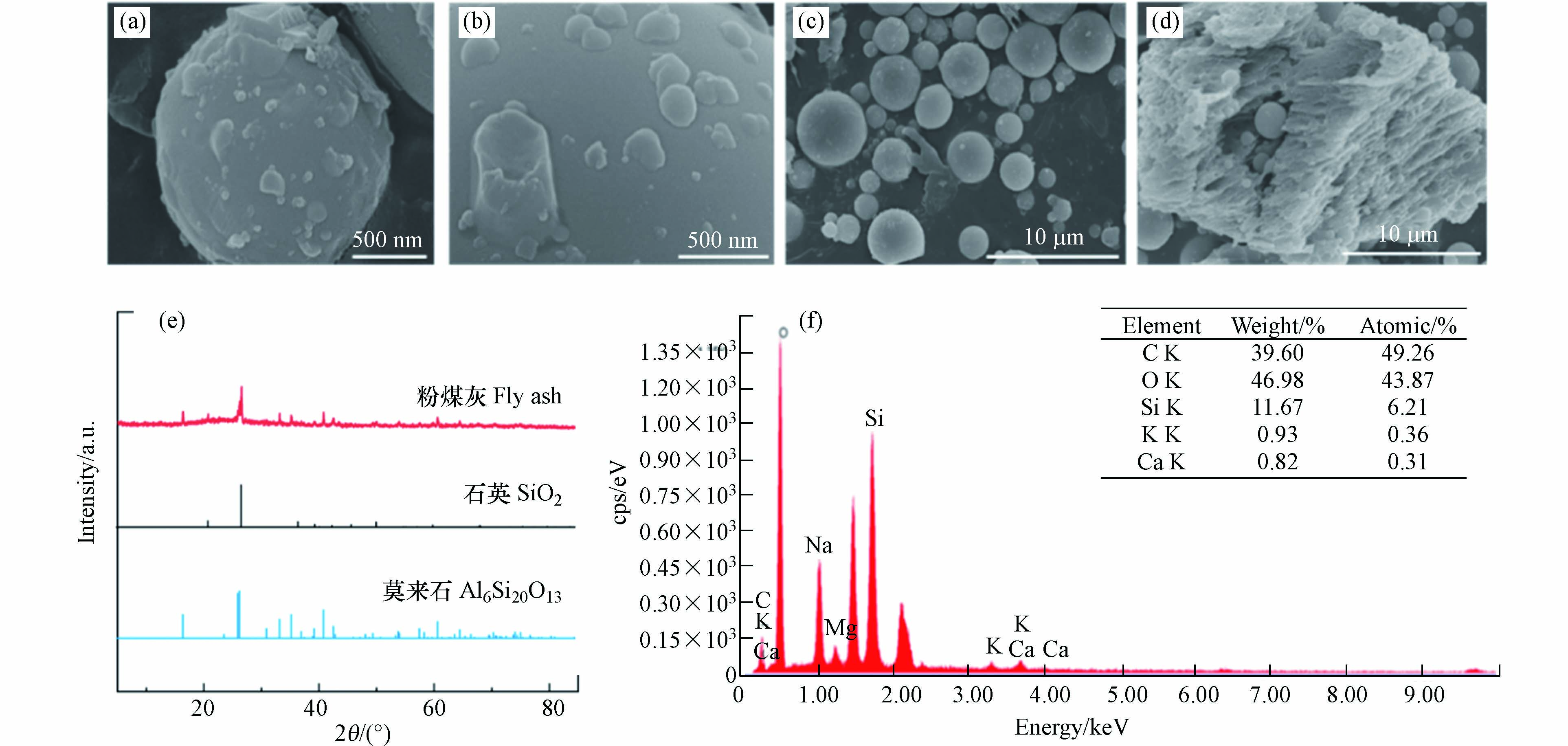
 下载:
下载:
